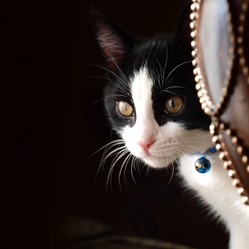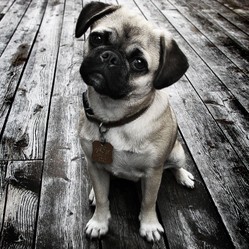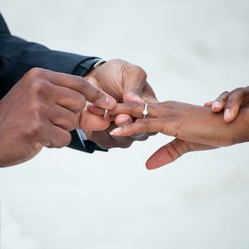Guile, persuasion, and even tempting tit-bits are wasted on the cat that does not want to co-operate. Unlike the dog, it will not obey commands, and unless it is in the right mood, it is a waste of time to attempt to photograph it; it should be left until another day. Many cats fear strangers, and most seem to sense whether a person is genuinely fond of their species or not, and react accordingly. Cats and kittens are small animals. Only cameras which permit the use of close-up lenses, or which have sufficient focusing extension will give really satisfactory pictures. If the camera is not suitable for going close enough to fill most of the negative with the animal, it is better to try for pictures of somebody holding a cat or the cat as a part of a more general scene.
Going close with a camera means that the viewfinder needs to be free of parallax, and that focusing must be most accurate.
Photographing Out-of-Doors
A sky background is perhaps even more suitable for a cat outdoors than a dog, since the cat is by nature a climber. The photograph should always make the most of the animal's good points. For example, if it has a strikingly-marked face, it will be worth while trying to get a close-up of the head. This might be tackled by putting the cat on somebody's lap who can calm the animal by stroking it, with the hand just out of picture. If one tries to hold on to a cat by force it will only struggle to get free, and will never yield a good picture. The animal must be at ease. In the final picture only the head of the cat would be shown. The beauty of close-up shots of this sort depends largely on getting them pin sharp.
With the cat on somebody's lap and the camera close enough to photograph the head of the cat only, the background will be out of focus even at the smallest stop. A small stop is necessary because of the lack of depth of field with such a close picture. Sunshine will therefore be best, and the more effective pictures will be those taken with sidelight or against the sun.
The best place to photograph a cat is where one finds it. In other words it is usually better to take the camera to the cat and not the cat to the camera. If it becomes necessary to place the animal, it should be put in a spot from where it cannot escape so easily, like the top of a garden wall, a small table, or a window ledge.
Generally speaking, at least some pictures should be taken from the level of the cat. This means holding the camera down on the ground, or putting the cat higher up. But any angles may give a good picture.
 | Pet Photography For Fun: Let's Have Fun Photographing Dogs, Cats, Horses, Alpacas, Llamas and Eve... A fun easy to use book on taking better pictures of pets including dogs, cats, horses, birds, alpacas, llamas and people with pets. The emphasis is on animal photography for ama... |
Photographing Indoors
Left to themselves, most cats will select a sunny spot to lie down in. This weakness for warmth is a great help. Indoors the cat will usually bask happily in direct sunlight on a window-ledge, which is both a characteristic setting and an ideal spot for a photograph. Also, the warmth of the fireside and a soft cushion will hold it for some time, and allow ample opportunity to set up tripod, lights and reflectors (so long as no ends of flex are allowed to dangle temptingly during the preparation).
It is best to prepare all lights and the camera before attempting to make the cat settle down. The warmth of your lamps may help to settle the animal, but if the job takes too long, and if the lamps are near, the cat may go to sleep.
Photofloods, as opposed to flash, have the advantage of rendering the cat's pupils as slits and not as large round openings which look most un-catlike. When using flash it is advisable to have either daylight or one other lamp on at the same time in order to make the cat's pupils contract.
Photographing Kittens
The natural curiosity of kittens lends itself to picture-making. A cotton reel or an empty box never fails to inspire them to a bout of hilarious clowning. Here also the table-top technique is the most convenient. Once the subject is confined within the limits of the table-top (and the depth of field of the lens), it is easy to attract its attention in any desired direction by dangling a string or making a sudden noise.
The more convincingly small and helpless a kitten can be made to appear in a photograph, the better. This can be done by including some object in the picture area to contrast with the kitten. Hard, angular box shapes will emphasize its fluffiness, a shopping basket accentuates its relative smallness, and so on. But the animal should never be decorated with bows of ribbon and frills. In all other particulars photographing kittens does not differ from photographing cats.
You might also like
Photographing Dogs and PuppiesPhotographing dogs is difficult. The best tip to anyone attempting to take pi...
Wedding Photography




 Photographic Styleon 10/14/2011
Photographic Styleon 10/14/2011
 Interchangeable Lenseson 09/28/2011
Interchangeable Lenseson 09/28/2011
 Negative Blisters and Blemisheson 09/17/2011
Negative Blisters and Blemisheson 09/17/2011
 Photographyon 08/22/2011
Photographyon 08/22/2011



Comments
taking photos of cats sounds so easy, but is so difficult. Digital cameras area great improvement because cats seem to disappear from the photo, or only their tail or one ear is visible. Their fluffiness often makes the whole picture out of focus. But i continue and take hundreds of cat photos and a few are really beautiful.